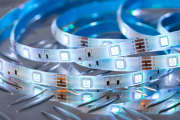1. LED Structure and Light-emitting Principle
The basics that semiconductor materials can generate light have been known for 50 years. The first commercial diodes were produced in 1960. The basic structure of LED is a piece of electroluminescent semiconductor material, which is placed on a lead frame, and then sealed with epoxy resin around it to protect the inner core wire. Therefore, the shock resistance of LED is good.
The core part of a light-emitting diode is a wafer composed of p-type semiconductors and n-type semiconductors. There is a transition layer between p-type semiconductor and n-type semiconductor, called p-n junction. In the PN junction of some semiconductor materials, when the injected minority carriers recombine with the majority carriers, the excess energy is released in the form of light, thereby directly converting electrical energy into light energy. When a reverse voltage is applied to the PN junction, it is difficult for minority carriers to inject, so it does not emit light.
This kind of diode made by the principle of injection electroluminescence is called light-emitting diode, commonly known as LED. When it is in a forward working state (that is, a forward voltage is applied to both ends), when the current flows from the LED anode to the cathode, the semiconductor crystal emits light of different colors from ultraviolet to infrared, and the intensity of the light is related to the current.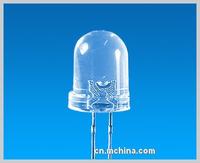
2. Features of LED Light Source
Voltage:
The LED uses a low voltage power supply, and the power supply voltage is between 6-24V, which varies according to the product, so it is a safer power supply than using a high voltage power supply, especially suitable for public places.
efficacy:
It consumes 80% less energy than incandescent lamps with the same light efficiency.
applicability:
Very strong, each unit LED chip is 3-5mm square, so it can be fabricated into devices of various shapes, and is suitable for variable environments.
stability:
100,000 hours, the light decay is 50% of the initial.
Response time:
The response time of its incandescent lamps is milliseconds, and the response time of LED lamps is nanoseconds.
Environmentally friendly: No harmful metal mercury.
colour:
Changing the current can change the color, and the light-emitting diode can easily adjust the energy band structure and band gap of the material through chemical modification methods, so as to realize multi-color emission of red, yellow, green, blue and orange. For example, an LED that is red when the current is small, can turn orange, yellow, and finally green as the current increases.
price:
The price of LEDs is relatively expensive. Compared with incandescent lamps, the price of several LEDs can be comparable to the price of one incandescent lamp. Usually, each group of signal lights needs to be composed of 300 to 500 diodes.
3. Types of Monochromatic Light LEDs and Their Development History
The earliest LED light source made of semiconductor P-N junction light emission principle came out in the early 1960s. The material used at that time was GaAsP, which emits red light (λp=650nm). When the driving current is 20 mA, the luminous flux is only a few thousandths of lumens, and the corresponding luminous efficiency is about 0.1 lumens/watt.
In the mid-1970s, the elements In and N were introduced to make LEDs produce green light (λp =555nm), yellow light (λp =590nm) and orange light (λp =610nm), and the luminous efficiency was also increased to 1 lumen/watt.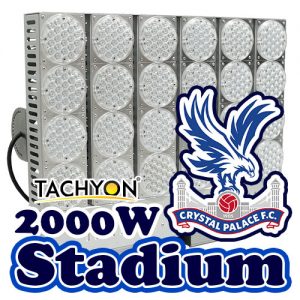
In the early 1980s, LED light sources of GaAlAs appeared, making the light efficiency of red LEDs reach 10 lumens/watt. In the early 1990s, two new materials, GaAlInP, which emits red and yellow light, and GaInN, which emits green and blue light, were successfully developed, which greatly improved the light efficiency of LEDs. In 2000, the luminous efficacy of LEDs made by the former reached 100 lumens/watt in the red and orange regions (λ p = 615nm), while the luminous efficacy of LEDs made by the latter in the green region ( λ p = 530nm) could reach 50 lumens/watt.
4. Application of Monochromatic Light LED
Originally LEDs were used as indicator light sources for instrumentation. Later, LEDs of various light colors were widely used in traffic lights and large-area display screens, resulting in good economic and social benefits.
Take a 12-inch red traffic light as an example. In the United States, a long-life, low-efficiency 140-watt incandescent lamp was originally used as the light source, which produced 2000 lumens of white light. After the red filter, 90% of the light is lost, leaving only 200 lumens of red light. In the newly designed lamp, Lumileds uses 18 red LED light sources, which consume a total of 14 watts of power including circuit losses, but can produce the same light effect.
Automotive signal lights are also an important area of application of LED light sources. In 1987, my country began to install high-mounted brake lights on cars. Due to the fast response speed of the LED (nanosecond level), the driver of the following vehicle can be informed of the driving situation as soon as possible, and the occurrence of rear-end collision accidents can be reduced.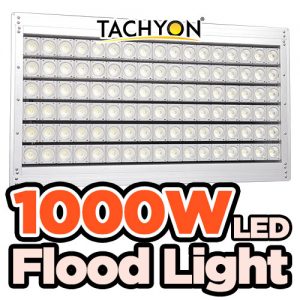
In addition, LED lights have been used in outdoor red, green and blue full-color display screens, key-chain micro flashlights and other fields.
5. Development of White LEDs
For general lighting, people need more white light sources. In 1998, LEDs that emit white light were successfully developed. The LED is made by encapsulating a GaN chip with yttrium aluminum garnet (YAG). The GaN chip emits blue light (λp=465nm, Wd=30nm), and the Ce3+-containing YAG phosphor made by high temperature sintering emits yellow light emission after being excited by this blue light, with a peak value of 550nm.
The blue LED substrate is mounted in a bowl-shaped reflective cavity, covered with a thin layer of resin mixed with YAG, about 200-500nm. Part of the blue light emitted by the LED substrate is absorbed by the phosphor, and the other part of the blue light is mixed with the yellow light emitted by the phosphor to obtain white light.
Now, for InGaN/YAG white LEDs, by changing the chemical composition of the YAG phosphor and adjusting the thickness of the phosphor layer, various colors of white light with a color temperature of 3500-10000K can be obtained.
In fact, LED lights are what we usually call energy-saving lamps. Different power LED lights, the price is not the same. And different craftsmanship and different exterior materials will also cause price differences.
6. Comparison and Competition of Advantages and Disadvantages of New Neon Lights and LED Lights
The following is a comparison between neon lights and LED lights, adding the latest LED technology into the comparison.
1). Does the LED light source have a lifespan of 10,000 hours?
According to the light decay of 7%, the actual time is only about 50,000 hours. According to the light decay of 3%, the actual application can reach 80,000 hours. The light decay of large particle products is 3%/year, and the light decay of small particle products is 7%/year.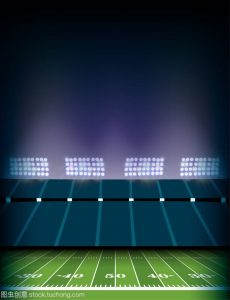
2). Will the LED not heat up?
Yes, cooling is required. The company adopts passive cooling method to solve the heat dissipation problem.
3). Can LEDs replace incandescent lamps?
Luminous flux, light efficiency and color rendering are OK, but are currently too expensive and will not decline in recent years. However, the cost of replacing incandescent lamps can be reduced by increasing the luminous flux of the product.
4). Can the LED be used simply as a common light source?
No, to drive power, optics and thermal conduction.
5). Comparison of the performance and advantages of the two light sources
The advantages of neon lights have been covered by LEDs, but LED lights are currently too expensive.
6). Comparison of the power supply of the two light sources
The LED low voltage is good, but the water resistance is poor and the load current is too large. The input current of the large particle 1 watt LED single lamp is 350mA.
7). Comparison of control technology of two light sources
LED is easy to implement, but neon is mature.
8). Comparison of the stability of the two light sources
The LED is inconsistent, and the neon is quite stable. A few manufacturers can achieve relative stability, such as combining CREE and AOD chips to take advantage of their respective chips.
9). The price comparison of the two light sources
LEDs are more expensive, but yellow and red are equal, and the most expensive is LED white light.
10). Comparison of two light sources for outdoor use
The poor waterproofness of LEDs is the Achilles heel for outdoor use.
11). Comparison of the current market of the two light sources
The annual output value of global lighting products is 42 billion US dollars, and the proportion of LED light sources is less than 20%.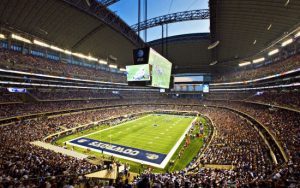
7. What is the Package of LED Light?
LED light package explanation:
Simply put, LED packaging is the process of packaging LED packaging materials into LED lights.
LED light packaging process:
Generally, the LED package must go through the processes of crystal expansion – solid crystal – bonding wire – glue filling – cutting feet – light separation and color separation.
LED light packaging material:
The main packaging materials of led are: chip, gold wire, bracket, glue, etc.
LED lamp packaging equipment:
Die expanding equipment, die bonding machine, wire bonding machine, glue dispenser, baking oven, etc., are generally divided into two types: automatic packaging equipment and manual packaging equipment.
8. How to Judge the Quality of LED Light Package?
Indicators of the quality of led lights:
Several indicators of the quality of led lights are: angle, brightness, color (wavelength) consistency, antistatic ability, anti-attenuation ability, etc.
Packaging materials for led lights:
The LED packaging material is the direct factor and the most basic factor for the quality of the LED lamp. LED lights are a combination of several main materials, and a good LED light must be a combination of all packaging materials and production technologies.
LED lamp packaging technology:
Generally, automatic equipment packaging is better than manual packaging. The technical level of packaging is also the main factor for the quality of LED lamp packaging. The products produced by different manufacturers of the same material are very different;
9. What Kind of LED Lights Are Needed to Make LED Display? ?
Appearance of led lights:
The production of outdoor led electronic screens mainly uses in-line oval led lights. The production of indoor led electronic screens mainly uses surface-mounted led lights.
Parameters of led lights:
The brightness varies according to the use environment and other factors, the wavelength of red light: 620nm-625nm, the wavelength of green light: 520nm-525nm, and the wavelength of blue light: 465nm-470nm.




